12 Wikipedia
Paul Thomas
Learning Objectives
After reading this chapter, you will be able to:
- Explain Wikipedia’s history and operations, and how these features can influence the site’s contents.
- Articulate the appropriate uses of Wikipedia.
- Participate in Wikipedia as an editor, creator and curator of original content.
The Least Reliable Source, Or Is It?
Wikipedia is a popular online encyclopedia that can be edited by anyone. Because of its open nature, many teachers and professors often warn students that it should never, under any circumstances, be used because it is “unreliable.” As with all things, the situation is much more nuanced than that. While Wikipedia is by no means a replacement for scholarly books and articles, it can be of immense use as an exploratory, tertiary source. Of course, it is not a perfect resource, and its contents should always be judged critically, but much of the fear surrounding the site comes from a place of ignorance.
In this chapter, we will explore the history of Wikipedia, what type of resource it is, whether or not it’s reliable, when it is appropriate to use the source, and how to become an editor. By the end, you should be more familiar with how the site operates, what roles editors have in maintaining this digital resource, and the benefits and downsides to using Wikipedia when doing research.
Brief History of Wikipedia
Arguably, we could trace the origins of Wikipedia back to the 1930s, when the sci-fi writer H.G. Wells proposed that a “Permanent World Encyclopedia” be created, compiled and edited by the world’s greatest minds. Or we could trace its origins to the mid-1990s, when Eric Hammer and Edward Zalta of Stanford University suggested that a “dynamic encyclopedia” be created, whose entries “can be improved and updated on a continual basis without requiring the production of an entirely new edition.”
However, most people consider the site to be a direct continuation of the project Nupedia, which was launched by Jimmy Wales in 1999. This encyclopedia project was intended to be a free online encyclopedia that was accurate and — perhaps most importantly — “academically respectable.” Like previous traditional encyclopedias, Nupedia was written only by experts, but it was open and free to use, making it quite revolutionary at the time.
Unfortunately, because Nupedia was written by unpaid experts, only about 20 articles were created, and due to this sluggishness, the project was soon abandoned. Wales, however, did not want his idea to go to waste. Using the wiki software that had sustained Nupedia, he launched a new site: Wikipedia. With this project, Wales originally wanted select content experts to peer-review and copy-edit material submitted by the public. Initially, few academics wanted to work on this new project, given how far-removed it was from traditional academic scholarship. So Wales left the project open to anyone. In time, the site became popular and grew rapidly. As of January 2019, the English version of the site boasted over 35 million editors, who collectively helped to create over 5.6 million articles, with an average of 800 new articles being created every day.
The truly remarkable thing about the site is that anyone — with or without a Wikipedia account — is free to modify the contents of the website. As such, Wikipedia, in many ways, is working to ensure that everyone the world over not only has access to knowledge, but can contribute to that vast collection of knowledge.
Is Wikipedia Reliable?
The question of whether Wikipedia is reliable has raged both online and offline since about 2005. Research studies have shown that Wikipedia is roughly as reliable as other sources commonly accepted as “accurate.” Arguably, the one to demonstrate this first was science journalist Jim Giles, who wrote a 2005 Nature article, “Internet encyclopaedias go head to head.” Giles combed through articles on both Wikipedia and the popular hard-bound Encyclopedia Britannica, concluding that between the two, “the difference in accuracy was not particularly great: the average science entry in Wikipedia contained around four inaccuracies; Britannica, about three.”
Further studies by The Guardian, the Journal of Clinical Oncology, PC Pro, the Canadian Library Association, and Library Journal have all found that Wikipedia is, for the most part, reliable.
None of this is to say that Wikipedia is perfect or 100 percent accurate. It is a human-produced product, and like all human creations, is bound to have flaws and inaccuracies. Because there is no one at the site whose sole job is to ensure that all articles are up to a certain standard, some articles have grammatical errors, poor organization, or out-of-date sources. Sometimes, an article will have good sources, but these sources may be misinterpreted or added to an article without meeting established standards.
But perhaps most dangerous is that Wikipedia articles can be heavily biased depending on the topic at hand. This is especially true for articles about famous people, places, and things, or controversial topics (e.g. U.S. presidents, climate change, certain religions). In articles such as these, some unscrupulous editors try to put forward an agenda by carefully wording certain sections or by adding biased sources. While their behavior is not to be commended, it can be said that these editors are clever. After all, they have realized that, because Wikipedia is used so often, by injecting their bias into an article, they can almost unconsciously affect readers’ opinions on the topics at hand.
Many times, this bias can be easily spotted, as inexperienced Wikipedia editors often make use of “peacock terms” in their writing. According to Wikipedia itself, peacock terms are grandiose words that tend “to promote the subject of an article, while neither imparting nor plainly summarizing verifiable information.” For example, in the sentence, “Company XYZ is the best publishing house in the United States,” the peacock term is the claim that the company is the best in the United States.
Others make use of “weasel words.” These are vague terms or phrases that, according to Wikipedia, “creat[e] an impression that something specific and meaningful has been said, when in fact only a vague or ambiguous claim has been communicated.” For example, in the sentence, “Some people say that Company XYZ is the most innovative publisher in the last 100 years,” the words “some people” signal the use of weasel words. Articles that feature these sorts of expressions often sound amateurish, and resemble puff pieces or promotional press releases, more so than encyclopedia articles.
Other times bias in articles can be much more insidious. One of the more infamous examples of this sort of problem is Wikipedia’s gender bias. According to a 2015 article published by the MIT Technology Review: “Despite well-publicized efforts to promote equality, Wikipedia articles are deeply biased against women, say computer scientists who have analysed six different language versions of the online encyclopedia.”
For a simple example, consider a 2011 survey conducted by the WikiMedia Foundation, which revealed that 91 percent of editors identify as male, whereas only 8.5 percent of editors identify as female. A later 2015 study by information scientist Eduardo Graells-Garrido and colleagues found “systematic asymmetries” on the site, meaning that many Wikipedia articles are biased toward one gender, usually men. The good news is that Wikipedia’s gender bias is currently being exposed and discussed.
It is now up to current and future Wikipedia editors to add good quality prose and sourcing to articles, thereby reducing this sort of bias, as well as other forms of bias that can lurk in articles. And the good news is that Wikipedia can be edited by anyone. That means that you can create an account and start to affect this sort of change.
When To Use Wikipedia?
When not to use it?
It is of paramount importance to realize that Wikipedia is a tertiary source. These sorts of resources, which also include encyclopedias, dictionaries, and thesauri, often collect primary or secondary sources, and arrange them in an easy-to-use way. They rarely have credited authors, and are almost always based on previous research. In other words, they merely compile or synthesize what has already been researched, proposed, or argued by others.
An excellent example of a tertiary source is a dictionary. While there might be an editor or a main compiler of a dictionary, it can’t be said that this person is the author of the dictionary. Furthermore, while dictionaries often add new words to new editions, in can’t be said that the dictionary invents these words. It merely reports which terms and phrases are being used by others and what these terms and phrases mean.
There’s nothing wrong with using tertiary sources for your research. In fact, they are often very helpful when you are trying to get a feel for an unfamiliar topic. But they should never be the only sources you consult, and dictionaries and encyclopedias should never be used to back-up the majority of your research or writing. Why might this be? For one thing, there are simply better sources out there than tertiary ones. Remember that tertiary sources effectively repackage those things which have already been argued or written about. Why would you cite an encyclopedia that relies on a handful of primary or secondary sources when you could simply use those primary or secondary sources themselves? There often is an expectation at the university level that students use scholarly or peer-reviewed sources for their research. While tertiary sources might undergo editorial review, they rarely are peer-reviewed to the level of a scholarly journal article or book.
When to use it
The tertiary nature of Wikipedia (and not its open access) is the main reason why you should not use it as your only source. With that said, there is a time and a place to use Wikipedia.
Let’s say that you have just been given an assignment to write about the history, structure, impact, and so on, of the Associated Press. You’ll notice that at the very bottom of the Associated Press’s Wikipedia article, there is a section called “References.” In this portion of the article, there are a number of useful links and citations, including two books that were published by university presses. If you’re wanting reliable secondary sources that discuss the AP, then it would be better to use and cite these sources listed in the References section, rather than the Wikipedia article itself.
Throughout the AP article, you’ll also note that many sentences, paragraphs, and sections are followed by footnoted numbers. These numbers lead the reader to specific sources that are listed in the “References” section at the bottom of the article. These footnotes can be very helpful if you need to know both a specific piece of information and the exact place (e.g., page number, website, chapter) where that piece of information came from. Once again, Wikipedia can be very useful in leading you in the “right direction” while you are researching.
A caveat to all of this: You might also notice that some sections in Wikipedia articles don’t have any footnotes backing up their claims. While the information contained in these sections might be accurate, the fact that they lack footnotes is a major red flag, suggesting that their assertions should be taken with a grain of salt or ignored entirely. If you’re using Wikipedia, you should ideally be looking for sources, not assertions lacking attribution.
Summary
The key to successfully using Wikipedia as a scholar is being able to evaluate whether the information and sources that you see in an article are reliable. While Wikipedia requires that all sources be of a certain standard (not to mention that seasoned Wikipedia editors often try their best to weed out bad information on the site), subpar and dubious information does linger in many articles.
So, when exactly is it OK to use Wikipedia? While all situations vary in regards to context and academic expectations, if you find yourself in one of the following instances, it is generally appropriate to use the site:
- To quickly look up a fact for general interest or when the stakes are low.
- To begin research by getting an idea about what has been said about a given topic.
- To look for useful sources (e.g., peer-reviewed articles, books published by a reliable third party, pertinent grey literature).
Conversely:
- Don’t cite Wikipedia in an academic paper or presentation.
- Don’t use Wikipedia as your only source.
- Don’t blindly accept what Wikipedia articles tell you just because there is a source attached. Like any source, the source listed in Wikipedia might be bad or inappropriately used.
What and Who Are Editors?
The lifeblood of Wikipedia are its contributors, or “editors.” Anyone in the world with internet access is allowed to be a Wikipedia editor. Most edits to the site are made by those who have not secured an account. They are identified in edit histories and on discussion pages by an Internet Protocol (or IP) address (e.g., “204.16.36.56”).
Anonymous and unregistered editing has several handicaps. First, IPs are unable to create new article pages. Second, they cannot upload pictures or other files. Finally, they must answer a CAPTCHA (a type of word-based test used to tell if someone is a human or an automated machine) if they want to insert an external link into an article. These handicaps exist to curb vandalism (i.e. the malicious disruption of article content).
Why should a person become a Wikipedia editor? There are many reasons, ranging from the idealistic (“You will be contributing to the global sum of knowledge”) to the pragmatic (“More editors means less work for everyone involved”). Perhaps the most important is that, as students of journalism, you are likely motivated by the desire to create reliable, accurate, and neutral content that will be used to inform the public about the world in which we all live. This, too, is the goal of Wikipedia editors.
Think of Wikipedia as a well where everyone — whether they want to admit it or not — gets their water. If someone poisons that well, it can make the whole community sick. Likewise, if someone adds bad or erroneous information to Wikipedia, it will be read the world over, which could have a very negative impact. It is thus the job of the Wikipedia editor to “remove the poison from the well” and prevent the spread of this false information. And given that as journalism students you are learning many key skills that can aid in this task (e.g., how to report objectively, how to collect references and evidence, how to be transparent in where you get your sources), you are among the best individuals to become editors and help make the encyclopedia a better resource for all.
How To Become an Editor
Although IPs make up the majority of Wikipedia’s editors, they carry less clout than their named counterparts, because their identities are highly anonymized and therefore seen as impersonal. Follow these steps to create a named account.
- Navigate to the top right corner of any Wikipedia article and click on the link that says “Create account.”
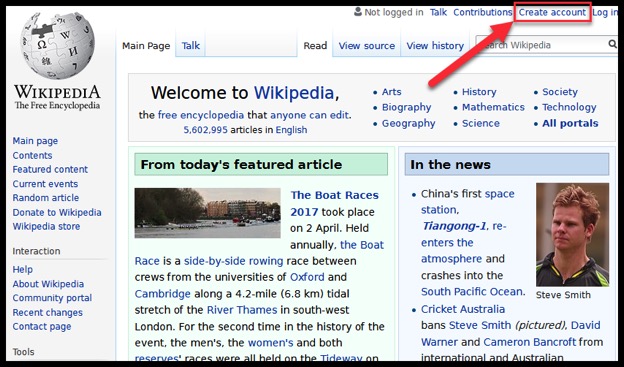
- You will be asked to create a username and password. NOTE: Don’t use your real name or other information that someone could use to ID you in real-life.
How To Edit Wikipedia
Making basic edits
Anyone can edit a Wikipedia article, whether or not they are a registered member. Articles can be edited by clicking on the link at the top of the screen that reads “Edit.”
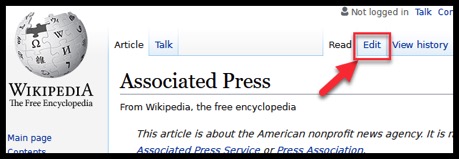
To the left side of any article heading is another “Edit” link.
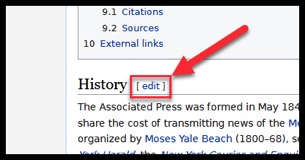
After you click on either of these “Edit” links, you will be redirected to the editing screen, wherein you can add or delete characters.
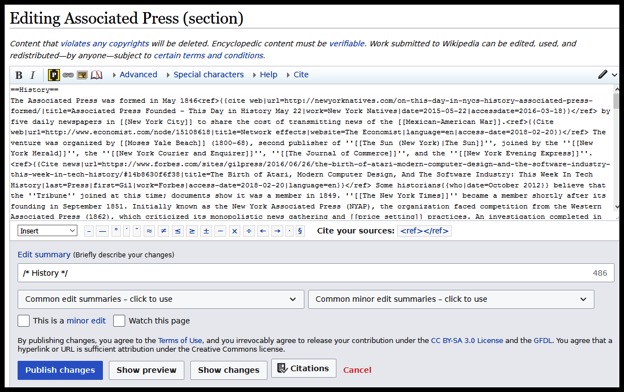
Linking to another Wikipedia article
Follow these steps to insert a hyperlink to another Wikipedia article.
- Highlight the word or phrase that you want to link.
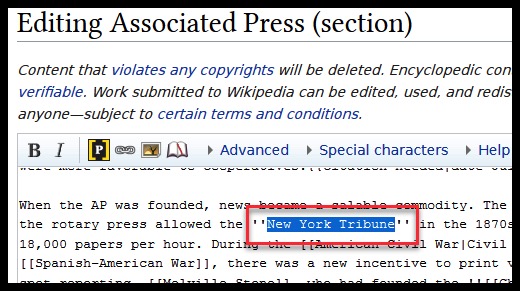
- Select the “Link” button from the options near the top of the editing screen:
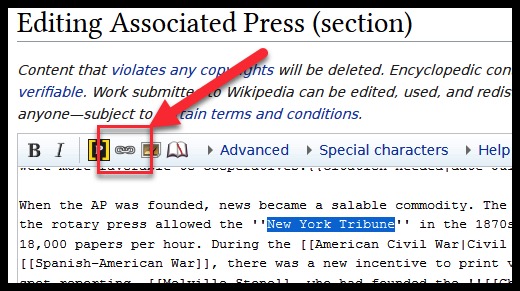
- You will see the following screen:

- “Target page or URL” is where you will put the name of the Wikipedia article to which you’d like to link.
- “Text to display” is where you will put that text that you want to appear in the Wikipedia article itself.
(The reason there are two different fields is because some Wikipedia articles have disambiguating phrases attached to their titles to separate them from other articles with similar names. For instance, “The Sun (New York City)” and “The Sun (Sydney)” are two separate articles about two different newspapers that are both named The Sun. If you’d like to insert a hyperlink to the former in an article, you’d want the “Target page or URL” box to read “The Sun (New York City)”, but the “Text to display” box to simply read “The Sun.”)
- Now, add in the appropriate target page and text (often, these fields will be identical), and click insert:
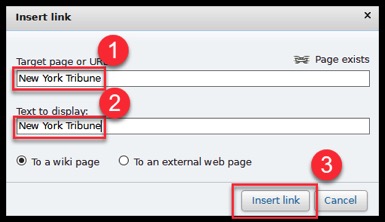
- Now, navigate to the bottom of the editing screen and click “Publish Changes.”

- This will add the link into the article.
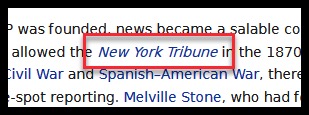
To insert a reference
Adding references to Wikipedia is of critical importance. Thankfully, Wikipedia has an easy way to format these citations.
- Place your cursor where you’d like to insert a citation. Then, on the edit screen, click on the tab that reads “Cite.”
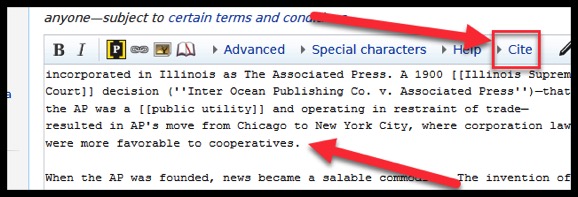
- Select what citation template you would like to use.

- A citation manager will pop up; enter in the necessary information and then click “Insert.”
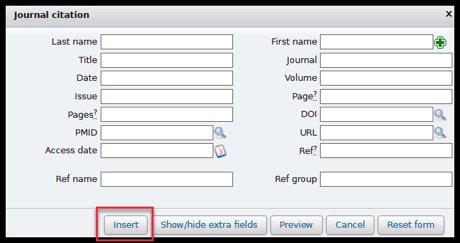
- The citation will appear in the edit box

- Go to the bottom of the edit screen and click “Publish Changes.” After doing so, you will see that the citation has been added to the article.
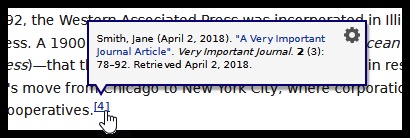
You’ll want to make sure that your article has a reference list template. Most large articles will already have one. If you are the first person to add a citation to a page, then you will need to add {{reflist}} to the end of the article.
To do this, go to the bottom of the article and click “Edit.” Then enter the following:
==References==
{{reflist}}
It will look like this:
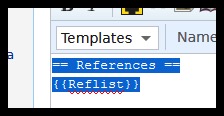
- When you’re all done, click “Publish changes” at the bottom of the editing screen. You can then see if the references are displaying correctly:
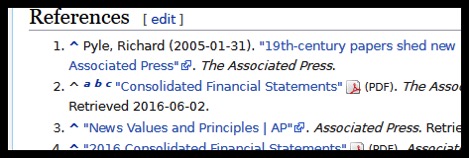
Activity 1: Wikipedia Sources
Locate a Wikipedia entry related to a topic you’re working on. Using the steps outlined in this chapter, locate at least two credible sources cited in the Wikipedia sources. In a one-to-two-page reflection, state which entry you found and what two sources you selected. Then explain why you believe the sources are credible and how you may use them in writing an article on your topic.
Activity 2: Cue-Evidence a Wikipedia Entry
Locate and read a Wikipedia entry related to a topic you’re working on. Using your knowledge from this chapter and preceding chapters on credibility, evaluation, and bias, write a one-to-two-page evaluation of your selected Wikipedia entry. Make certain to clearly cite the Wikipedia entry under review, and state and explain your criteria for its credibility, providing clear examples. You might discuss such aspects as: Was the entry helpful, well sourced, well written, complete, accurate, biased? In what ways?
Activity 3: Source Genres
In your academic assignments your instructors might require a variety of sources or even specific genres, or types, of sources to be cited. Identify and compares/contrast the different types of sources used in the Wikipedia article used for Activity 1 or 2. Critically analyze if these genres are appropriate for the article, and if or how citing additional genres would improve the credibility of the article.
Activity 4: Open Pedagogy
Create a live-action tutorial for creating a Wikipedia account or editing an article. You can use technology of your choosing, but the tutorial must be fewer than three minutes.

